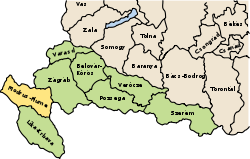Modruš-Rijeka County
| Modruš-Rijeka County Modruško-riječka županija Modrus-Fiume vármegye |
|||||
| County of the Kingdom of Croatia-Slavonia | |||||
|
|||||
|
Coat of arms |
|||||
| Location of the County (yellow) within the Kingdom of Croatia-Slavonia (green) | |||||
| Capital |
Ogulin 45°16′N 15°14′E / 45.267°N 15.233°ECoordinates: 45°16′N 15°14′E / 45.267°N 15.233°E |
||||
| History | |||||
| • | Established | 12th century | |||
| • | Treaty of Trianon | 4 June 1920 | |||
| Area | |||||
| • | 1910 | 4,879 km2(1,884 sq mi) | |||
| Population | |||||
| • | 1910 | 231,654 | |||
| Density | 47.5 /km2 (123 /sq mi) | ||||
| Today part of | Croatia | ||||
Coat of arms
The Modruš-Rijeka County (Croatian: Modruško-riječka županija; Hungarian: Modrus-Fiume vármegye) was a historic administrative subdivision (županija) of the Kingdom of Croatia-Slavonia. Croatia-Slavonia was an autonomous kingdom within the Lands of the Crown of Saint Stephen (Transleithania), the Hungarian part of the dual Austro-Hungarian Empire. Its territory is now in western Croatia. Modruš is a small town near Ogulin; Rijeka is a large city on the Adriatic coast. However, Rijeka (then officially Fiume) was not part of the Modruš-Rijeka County, but under the direct administration of Hungary. The capital of the county was Ogulin.
The Modruš-Rijeka County shared borders with the Austrian lands Istria, Carniola and Bosnia-Herzegovina and the counties of Zagreb and Lika-Krbava (both in Croatia-Slavonia). The county had a strip of Adriatic Sea coast. Its area was 4879 km² around 1910.
...
Wikipedia


